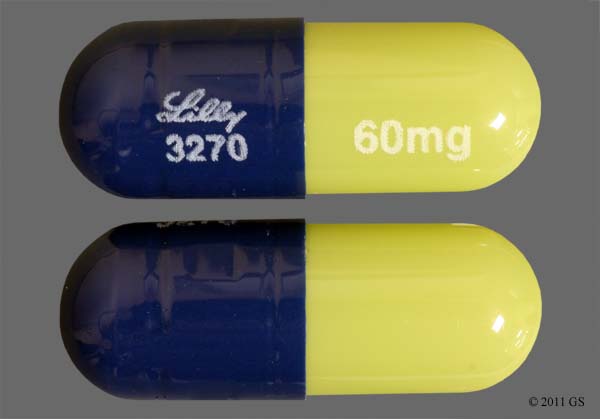Duloxetine | Cymbalta
Cymbalta® is a serotonin and norepinephrine reuptake inhibitor (SNRI) indicated for:
- Major Depressive Disorder (MDD) (1.1) Efficacy was established in four short-term and one maintenance trial in adults (14.1).
- Generalized Anxiety Disorder (GAD) (1.2) Efficacy was established in three short-term and one maintenance trial in adults (14.2).
- Diabetic Peripheral Neuropathic Pain (DPNP) (1.3)
- Fibromyalgia (FM) (1.4)
- Chronic Musculoskeletal Pain (1.5)
Cymbalta should generally be administered once daily without regard to meals. Cymbalta should be swallowed whole and should not be chewed or crushed, nor should the capsule be opened and its contents be sprinkled on food or mixed with liquids (2.1).
- Some patients may benefit from starting at 30 mg once daily.
- There is no evidence that doses greater than 60 mg/day confers additional benefit, while some adverse reactions were observed to be dose-dependent.
- Discontinuing Cymbalta: A gradual dose reduction is recommended to avoid discontinuation symptoms (5.6).
Dosage Forms and Strengths: 20 mg, 30 mg, and 60 mg capsules (3)

—–INDICATIONS AND USAGE—–
- See description above.
—–DOSAGE AND ADMINISTRATION—–
- See description above.
—–CONTRAINDICATIONS—–
- Use of a monoamine oxidase inhibitor concomitantly or in close temporal proximity (4.1)
- Use in patients with uncontrolled narrow-angle glaucoma (4.2)
—–WARNINGS & PRECAUTIONS—–
- Suicidality: Monitor for clinical worsening and suicide risk (5.1).
- Hepatotoxicity: Hepatic failure, sometimes fatal, has been reported in patients treated with Cymbalta. Cymbalta should be discontinued in patients who develop jaundice or other evidence of clinically significant liver dysfunction and should not be resumed unless another cause can be established. Cymbalta should not be prescribed to patients with substantial alcohol use or evidence of chronic liver disease (5.2).
- Orthostatic Hypotension and Syncope: Cases have been reported with duloxetine therapy (5.3).
- Serotonin Syndrome, or Neuroleptic Malignant Syndrome (NMS)-like reactions: Serotonin syndrome or NMS-like reactions have been reported with SSRIs and SNRIs. Discontinue Cymbalta and initiate supportive treatment (5.4, 7.14).
- Abnormal Bleeding: Cymbalta may increase the risk of bleeding events. Patients should be cautioned about the risk of bleeding associated with the concomitant use of duloxetine and NSAIDs, aspirin, or other drugs that affect coagulation (5.5, 7.4).
- Discontinuation: May result in symptoms, including dizziness, nausea, headache, paresthesia, fatigue, vomiting, irritability, insomnia, diarrhea, anxiety, and hyperhidrosis(5.6).
—–WARNINGS & PRECAUTIONS (CONTINUED)—–
- Activation of mania or hypomania has occurred (5.7).
- Seizures: Prescribe with care in patients with a history of seizure disorder (5.8).
- Blood Pressure: Monitor blood pressure prior to initiating treatment and periodically throughout treatment (5.9).
- Inhibitors of CYP1A2 or Thioridazine: Should not administer with Cymbalta (5.10).
- Hyponatremia: Cases of hyponatremia have been reported (5.11).
- Hepatic Insufficiency and Severe Renal Impairment: Should ordinarily not be administered to these patients (5.12).
- Controlled Narrow-Angle Glaucoma: Use cautiously in these patients (5.12).
- Glucose Control in Diabetes: In diabetic peripheral neuropathic pain patients, small increases in fasting blood glucose, HbA1c, and total cholesterol have been observed (5.12).
- Conditions that Slow Gastric Emptying: Use cautiously in these patients (5.12).
- Urinary Hesitation and Retention (5.13).
—–ADVERSE REACTIONS—–
- Most common adverse reactions (≥5% and at least twice the incidence of placebo patients): nausea, dry mouth, somnolence, fatigue, constipation, decreased appetite, and hyperhidrosis (6.3).
—–DRUG INTERACTIONS—–
- Potent inhibitors of CYP1A2 should be avoided (7.1).
- Potent inhibitors of CYP2D6 may increase duloxetine concentrations (7.2).
- Duloxetine is a moderate inhibitor of CYP2D6 (7.9).

